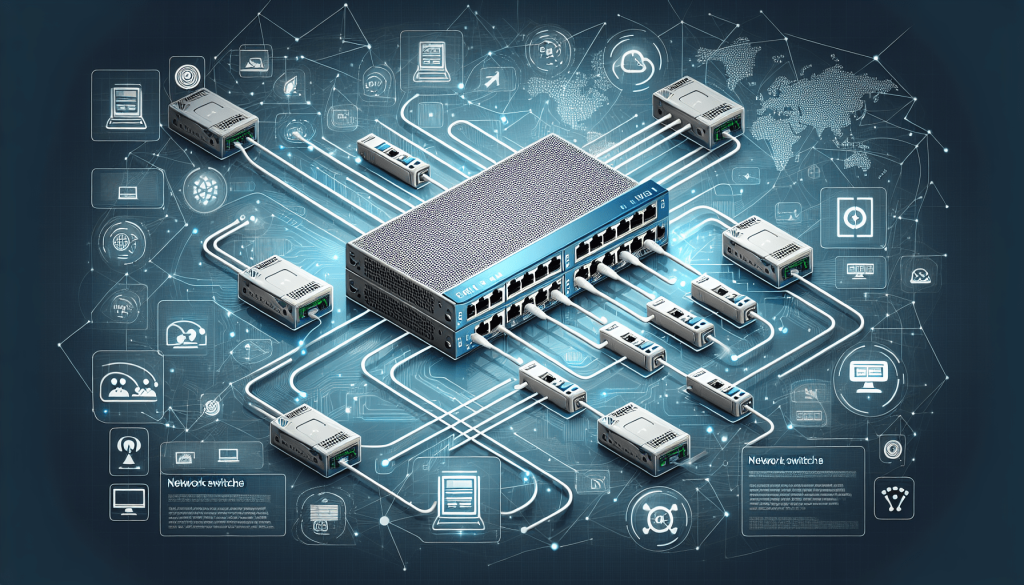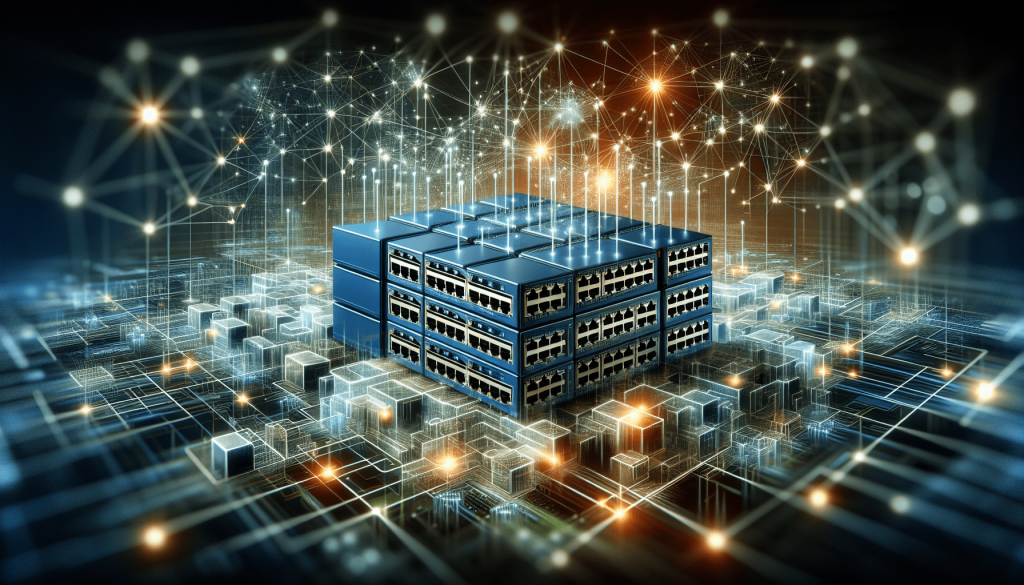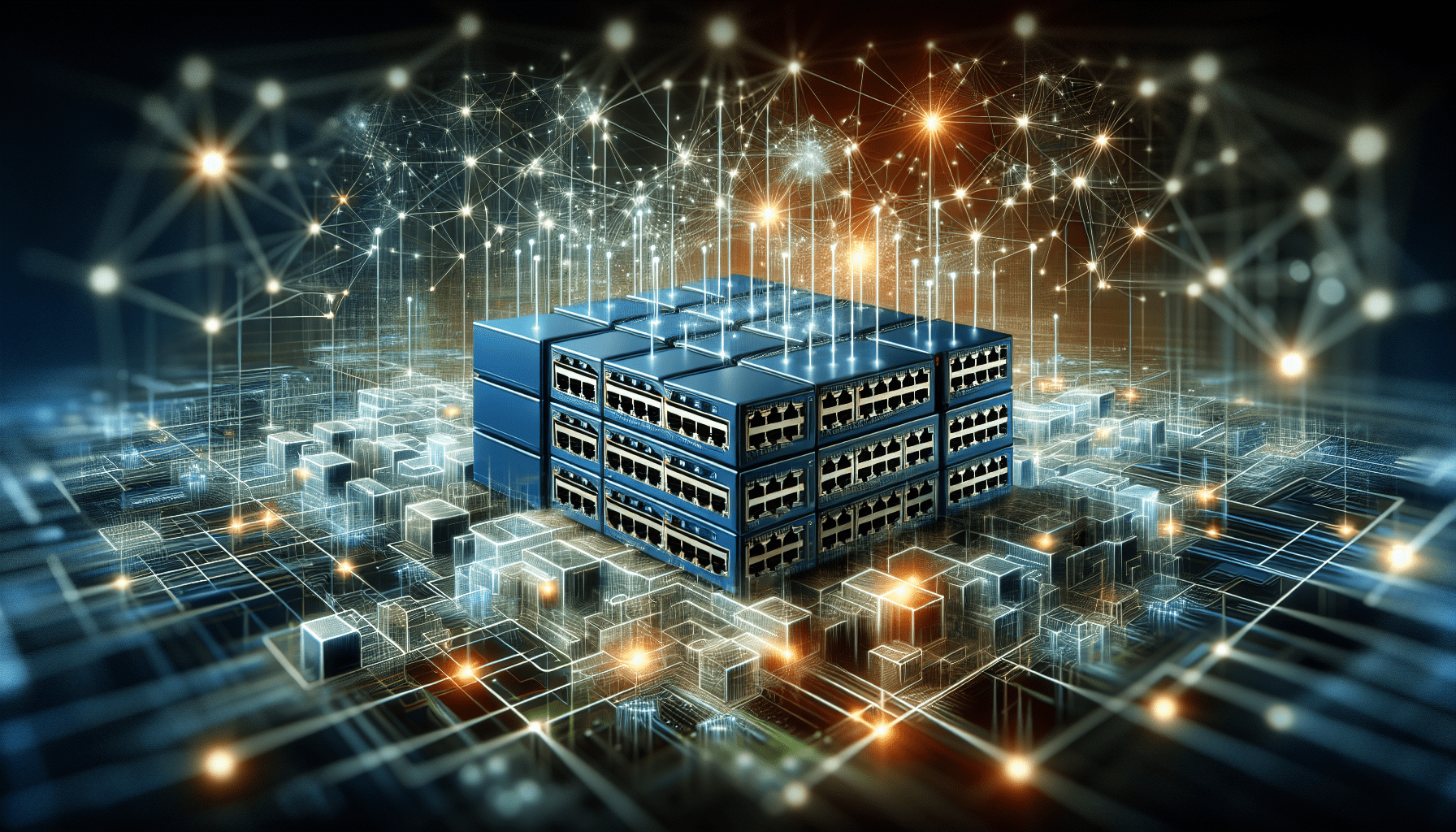In this article, you will gain a deeper understanding of the functionality of network switches. With a network switch being a crucial component in any computer network, it is important to know how it operates. Exploring the inner workings of a network switch will unveil its ability to control the flow of data and direct it to the appropriate destination, enhancing the efficiency and performance of your network. By the end of this article, you will have a solid grasp on the functionality of network switches and their significance in maintaining a smoothly running network. So let’s dive right in!
Understanding the Functionality of Network Switches
Introduction
Network switches are essential components in modern computer networks, enabling the efficient and secure transmission of data packets between devices. Whether you’re a tech enthusiast or a network administrator, understanding the functionality of network switches is crucial for optimizing network performance and troubleshooting connectivity issues.
Components of Network Switches
Network switches consist of several key components that work together to facilitate data transfer:
Switching Fabric
The switching fabric is the backbone of a network switch, responsible for connecting all the switch’s ports and enabling the flow of data packets. It determines the switch’s capacity to handle simultaneous data transmissions, known as its switching capacity.
Ports
Ports are physical interfaces on a network switch that allow devices to connect to the network. Each port can support a specific data transfer speed, such as 10/100/1000 Mbps or even higher. Ports may be labeled and grouped for different purposes, such as uplink ports, which connect switches together or provide connectivity to external networks.
CPU
The CPU (Central Processing Unit) in a network switch handles tasks such as managing switch configuration, processing network protocols, and making forwarding decisions. The CPU’s power and capabilities influence a switch’s overall performance.
Memory
Network switches have two types of memory: RAM (Random Access Memory) and flash memory. RAM stores tables and buffers needed for switch operation, while flash memory stores the switch’s operating system and configuration files. Sufficient memory is vital for efficient packet forwarding and handling various network protocols.
Power Supply
To keep a network switch operational, a reliable power supply is necessary. Power supplies can vary, from internal power supplies that connect directly to a switch to external power adapters, depending on the switch model.

Types of Network Switches
Understanding the different types of network switches is crucial for choosing the right one for your network infrastructure. Here are some common types of network switches:
Unmanaged Switches
Unmanaged switches are simple plug-and-play devices that require no configuration. They are typically used in small networks and offer basic functionality, such as port connectivity and data transfer.
Managed Switches
Managed switches provide advanced features and configuration options. Network administrators can monitor, manage, and control these switches, making them ideal for medium to large networks. Managed switches offer features like VLANs, Quality of Service (QoS), and security protocols.
Layer 2 Switches
Layer 2 switches operate at the data link layer of the OSI (Open Systems Interconnection) model. They use MAC addresses to forward data packets between devices within the same network or VLAN.
Layer 3 Switches
Layer 3 switches combine the functionality of switches and routers. They can make routing decisions based on IP addresses, allowing for inter-VLAN routing and faster data transfer within a network.
Stackable Switches
Stackable switches enable network administrators to connect multiple switches into a single logical unit. By stacking switches, you can increase port density, improve redundancy, and simplify network management.
PoE (Power over Ethernet) Switches
PoE switches provide power to connected devices, such as IP phones, wireless access points, and security cameras, through Ethernet cables. They eliminate the need for separate power sources and simplify network deployment.
Basic Operation of Network Switches
Network switches employ various mechanisms to efficiently forward data packets, ensuring fast and accurate delivery. The basic operation involves the following key processes:
Layer 2 Switching
Layer 2 switching is the core function of network switches. When a switch receives a data packet, it checks the destination MAC address and forwards it out of the appropriate port. This process eliminates the need for broadcasting data to all ports, improving network efficiency.
Layer 3 Switching
In addition to Layer 2 switching, Layer 3 switches can perform IP routing functions, enabling efficient routing between different networks. Layer 3 switches use IP addresses to make forwarding decisions, improving network scalability and performance.
Store-and-Forward vs Cut-Through Switching
Network switches can employ two different packet forwarding methods: store-and-forward and cut-through switching. In store-and-forward switching, the switch verifies the integrity of the entire packet before forwarding it, ensuring error-free transmission. Cut-through switching, on the other hand, forwards packets as soon as the destination MAC address is identified, resulting in lower latency but with a higher risk of transmitting faulty packets.
Packet Forwarding
Once a switch identifies the destination MAC address of a packet, it forwards the packet directly to the appropriate port. By eliminating the need to broadcast data to all ports, switches improve network efficiency and reduce collision domains.

Port-Based Switching
What is Port-Based Switching?
Port-based switching is a switching technique where each switch port behaves as an independent collision domain. It allows simultaneous full-duplex communication between connected devices, improving network performance and eliminating collisions.
Switching Domains
In port-based switching, each port represents a separate switching domain, enabling efficient data transfer between devices connected to different ports. This segregation eliminates the possibility of data collisions and enables full-duplex communication.
Full-Duplex and Half-Duplex Modes
Switches support both full-duplex and half-duplex modes of communication. In full-duplex mode, devices can simultaneously transmit and receive data, maximizing network bandwidth and minimizing latency. In contrast, half-duplex mode allows devices to either transmit or receive data at a time, leading to potential collisions and reduced efficiency.
Collision Domains
A collision domain is a network segment where devices share the same broadcast domain and compete for the same network resources. In port-based switching, each port represents a separate collision domain, ensuring that data transmissions are secure and collision-free.
MAC Address Learning
How Does MAC Address Learning Work?
MAC address learning is a vital process in network switches that allows them to determine the appropriate port for forwarding data packets. When a switch receives a packet, it examines the source MAC address and updates its forwarding table accordingly.
Forwarding Table
A forwarding table, also known as a MAC address table or CAM (Content Addressable Memory) table, is a database within a switch’s memory that associates MAC addresses with corresponding switch ports. By continuously updating this table based on incoming packets, switches can efficiently forward data to the correct destination.
Unicast vs Broadcast Frames
A unicast frame is a data packet that is sent from one sender to a specific recipient. Switches use MAC address learning to associate the source MAC address of a unicast frame with the port on which it was received. This way, subsequent unicast frames intended for that MAC address can be forwarded directly to the associated port.
In contrast, a broadcast frame is a data packet meant for all devices within the same network. Switches flood broadcast frames to all ports except the originating port, ensuring that all devices receive the broadcasted information.
Unknown Unicast Flooding
When a switch receives a frame with an unknown destination MAC address, it engages in a process called unknown unicast flooding. The switch forwards the frame to all ports except the originating port, in an attempt to ensure that the destination device receives the frame. If the destination device is present on the network, it responds to the frame, allowing the switch to learn the corresponding MAC address and update its forwarding table accordingly.
Forwarding Frames
Frame Destination Determination
When a switch receives a frame, it examines the destination MAC address to determine the appropriate port for forwarding. If the MAC address is present in the forwarding table, the switch forwards the frame directly to the associated port. If the MAC address is unknown, the switch either floods the frame to all ports (in the case of broadcast frames) or engages in unknown unicast flooding (in the case of unknown unicast frames).
Unicast, Multicast, and Broadcast Frames
Network switches handle three types of frames differently: unicast, multicast, and broadcast frames.
Unicast frames are sent from a single sender to a specific recipient. The switch uses MAC address learning to forward unicast frames directly to the associated port.
Multicast frames are sent from a single sender to a group of recipients. Switches use multicast group tables and IGMP (Internet Group Management Protocol) snooping to determine the appropriate ports for forwarding multicast frames.
Broadcast frames are sent from a single sender to all devices on the network. Switches flood broadcast frames to all ports except the originating port, ensuring that all connected devices receive the broadcasted information.
Frame Filtering
Switches are capable of filtering frames based on specific criteria, such as VLAN membership, MAC address, or protocol. This filtering process allows for better network security and can help optimize network performance by reducing unnecessary traffic.
Switching Modes
Network switches can operate in different switching modes, such as store-and-forward, cut-through, or fragment-free. The switching mode determines the amount of packet analysis the switch performs before forwarding the data, affecting latency, error detection, and network efficiency. Each switching mode has its advantages and trade-offs, and the choice depends on the specific network requirements and characteristics.
Virtual LANs (VLANs)
What are VLANs?
VLANs (Virtual LANs) are a logical segmentation of a physical network into multiple virtual networks. VLANs allow network administrators to group devices together, regardless of their physical location, facilitating better network management, security, and traffic control.
Benefits of VLANs
VLANs offer several benefits, including improved network security, reduced broadcast traffic, and simplified network management. By segregating devices into smaller logical networks, VLANs prevent unauthorized access and limit the potential impact of security breaches. VLANs also reduce broadcast traffic by containing it within specific VLANs, preventing unnecessary network congestion. Furthermore, VLANs simplify network management by allowing administrators to apply specific policies, such as QoS settings or access control lists, to individual VLANs.
VLAN Tagging
VLAN tagging is a mechanism used to identify VLAN membership of network frames. It involves adding a VLAN tag to the Ethernet frame’s header, indicating the VLAN ID to which the frame belongs. Switches with VLAN capabilities can examine this tag and appropriately forward frames within the VLAN.
VLAN Trunking
VLAN trunking is the process of carrying multiple VLANs across a single physical link or port. It allows for the simultaneous transmission of traffic belonging to different VLANs, enabling efficient communication between devices connected to different VLANs. Trunking protocols, such as IEEE 802.1Q, facilitate this process by encapsulating VLAN-tagged frames and allowing them to traverse trunk links.
Quality of Service (QoS)
Quality of Service (QoS) is a set of technologies and techniques used to prioritize network traffic and ensure the delivery of critical data with reduced latency and improved performance. QoS allows network administrators to allocate network resources based on the specific needs of different applications or users.
QoS mechanisms involve traffic classification, queuing, congestion management, and bandwidth allocation. By assigning different levels of priority to network traffic, QoS ensures that time-sensitive traffic, such as voice and video, receives sufficient resources for optimal performance.
Spanning Tree Protocol (STP)
The Spanning Tree Protocol (STP) is a network protocol designed to prevent network loops in redundant switch topologies. Redundancy is essential for network resilience and high availability, but it can lead to broadcast storms and packet collisions if not controlled.
STP dynamically selects one switch within the spanning tree to function as the root bridge, responsible for managing the spanning tree topology. It then determines the optimal paths between switches, disabling redundant links to prevent loops. If a link or switch in the network fails, STP automatically recalculates the spanning tree and redirects traffic through alternative paths.
Conclusion
In conclusion, understanding the functionality of network switches is vital for effectively managing and troubleshooting network infrastructure. From the basic components to the different types of switches, each element plays a crucial role in enabling efficient data transfer. Features like port-based switching, MAC address learning, and VLANs further enhance network performance and security. As technology continues to evolve, network switches will continue to play a crucial role in ensuring seamless connectivity and data transmission in modern computer networks.
